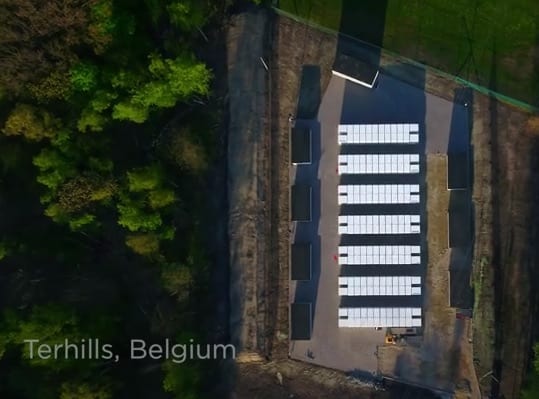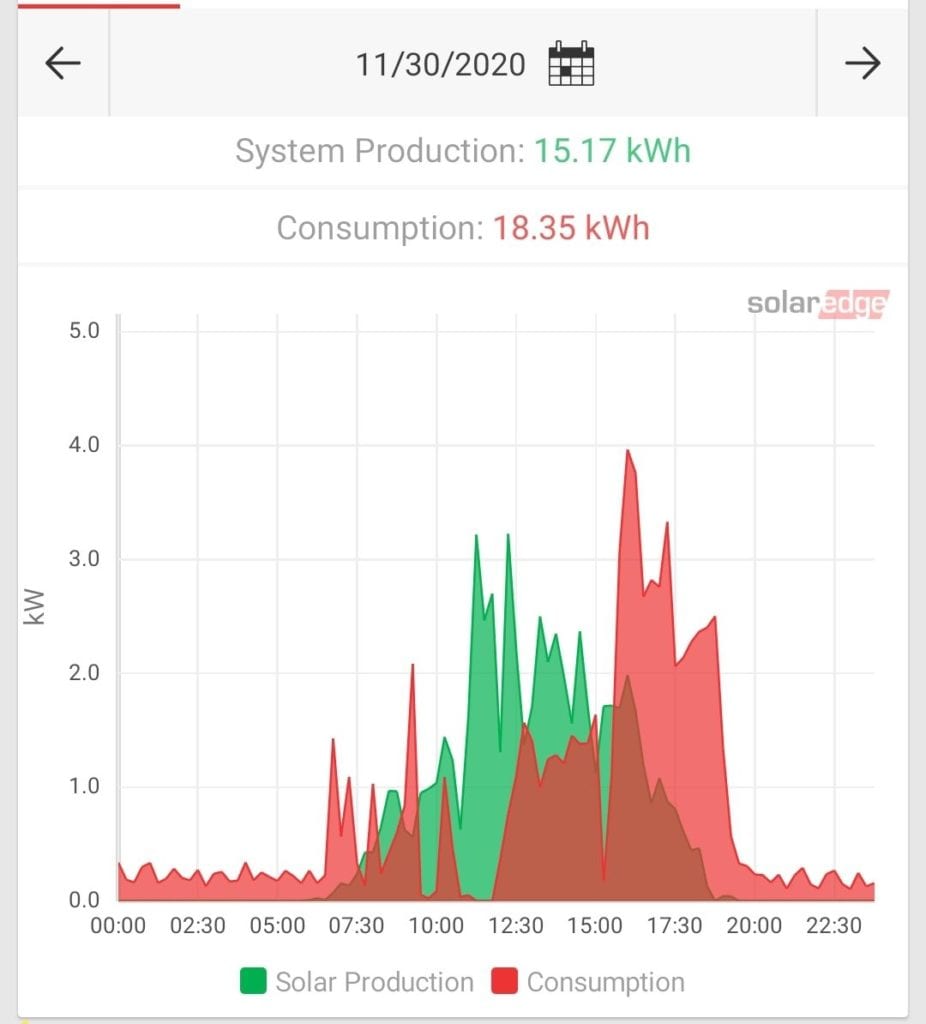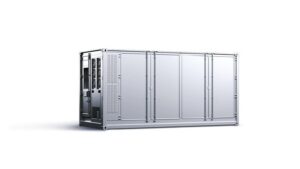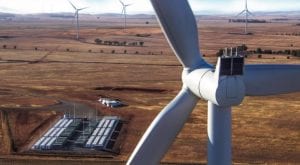Battery storage is coming to a grid near you, if it’s not there already. Little ones in households and big ones like in Hornsdale, South Australia, are being deployed in support of the clean energy revolution.
But what are they doing there? What can batteries do?
For starters, they’re not really “batteries”, more accurately they’re a battery energy storage system; we have a few at work and we call them “BESS” when we’re being formal, but normally just batteries.
The battery part is just where the energy is stored, and it is usually thousands of cells connected in series and parallel to achieve the desired voltage and current. This is the DC (direct current) part of the system, an energy storage reservoir hidden away inside the BESS.
In modern systems these cells are almost always based on a lithium chemistry, normally Lithium-ion or Lithium Iron-Phosphate, with a few more exotic chemistries in niches.
The cells are protected by the Battery Management System, often called the BMS. A BESS is a bit of an onion, layers of system wrapped around each other.
At the centre is the cells, the chemical batteries where the energy is stored. Wrapped around the cells is the BMS, a software and control system that monitors the vital statistics of the cells and controls the things that make sure the cells stay in specification.
Not all BMS are created equal, some just measure voltage at the DC terminals of the whole array and the temperature. Others measure the temperature, voltage, state of charge and current flow out of each individual cell and can tune their protection accordingly.
A good BMS is one way that smart companies can differentiate the quality of their BESS.
Next layer out is the inverter, which is really a bi-directional inverter-rectifier/charger. Inverter takes DC power and turns it into AC (alternating current) for the grid, a rectifier takes AC and turns it into DC, a charger controls how DC goes into the cells.
Despite this complexity, we’ll keep calling it the inverter.
In solar and BESS systems, the inverter is the bit that interfaces the electricity production with the grid. I would argue it’s the most important part of the system, once you’re beyond a minimum quality standard in solar panels and battery cells. Inverters are where the magic happens.
In our household system, the inverter is like a traffic controller, directing electricity to where it’s needed. If the sun is shining and there are loads in the house, power gets directed there. If our solar was export limited it would ramp down the power output if there aren’t household loads.
The inverter also controls battery charge and discharge, which in a house is quite simple; if the sun is shining and battery has capacity, charge battery. If the sun is not shining, there are loads on the house and the battery has charge, then discharge the battery.
That’s most of the algorithm in our house. Additional complexity is possible with off-peak charging and similar time of use tweaking, and this also comes from the inverter.
The outer layer of the onion is the control system beyond your site that orchestrates your battery as part of a larger system. The Virtual Power Plant in South Australia, or a third-party controller like Reposit are good examples of this.
What can batteries do?
The capabilities of a battery are almost entirely governed by the inverter. The cells play a role, they need to be able to give or take DC power quickly enough to keep up with the inverter, but they’re basically just a bucket of energy to keep the inverter happy.
The battery and inverter might be different components, which we call a DC coupled system, or the same box, an AC coupled system, but they perform the same, the inverter governs the battery capabilities.
At a minimum, the inverter will be able to make AC power from DC and put it into the grid safely, take power from solar panels or the grid to charge the cells and control the charging of the cells to keep them healthy.
They will monitor solar production, household power and the grid status to control charging and discharging the battery, depending on the operating mode. Most batteries are just capturing solar export and discharging it at night, and they turn off if the grid drops.
It’s not intuitive, but having a battery doesn’t mean you’re immune to blackouts, and this requires additional hardware and smarts.
Like solar inverters, battery inverters must turn off when there is a grid blackout. This sounds like a conspiracy, but there’s a genuine safety reason that must be followed; if the grid is down, and you connect a generator to it and put power in, that could injure someone working on those lines.
I have heard this is a genuine problem after cyclones. Lines go down all over the place, old mate remembers he’s got a generator out the back, and re-energises the house. It also puts power back into unknown parts of the remaining network.
To get power during a blackout, the house needs to disconnect from the grid first. In a blackout the inverter detects no voltage from the grid and opens a contactor which breaks the connection from the grid to the house.
The inverter then starts its own grid just for the house. A good inverter will be able to do this very quickly, enough to not even make the TV flicker. Check out the Inertia post for more on these grid forming inverters.
That’s pretty much the limit of residential inverters, grid forming capability for some, generally just shifting solar, some might be fast enough to be part of orchestrated systems like the Virtual Power Plant.
At commercial scale inverters become more sophisticated and don’t just plod along absorbing solar to discharge it at dinner time, they’re fast and sophisticated enough to modify the quality of electricity in the area in real time.
At this scale, battery systems become the most sophisticated power supply in the grid and by some margin. Good inverters have what they call symmetrical 4-quadrant power which basically means they can charge and discharge at full power, from power factor of 1 to zero. They can make any type of AC electricity possible, in a matter of milliseconds.
As an example, I’ve seen specs on a 1MW battery that can go from charging at 1MW, to discharging at 1MW in 50ms, then back again in another 50ms. For one this is way faster than the fastest conventional generators in the electricity network.
A fast-start diesel generator might make it from off to on in 30s if things go well, then ramp from 30% to 100% over 30s. I’ve heard a hydro turbine can get down to 10s or but I’m having trouble believing they could synchronise in that time. A battery could go from off to on about 100 times in 10 seconds.
What makes them peerless though is that batteries can act as a negative power supply as well. Sure they can charge up and store power, that’s what we mostly think of them doing, but pumped hydro can do that.
Apply a constant load to the grid and pump water up hill. A battery can take power from the grid too, but it can vary that demand as quickly as it can vary its output.
This is easiest to think about in microgrid applications, with a limited number of loads and power supplies. These grids must keep the balance between supply and demand very tight to maintain frequency, which means the supplies need to be able to respond as quickly as the loads. Lots of little diesel grids around the world will be adding solar and batteries now, because it’s cheaper, but also because it works better.
Imagine a small school grid running on a diesel generator. It’s fine when the lights and computers are working, but when the water pump comes on the generator lags and the lights and computers flicker.
That’s because the generator can’t change output quickly enough. A little battery in parallel with that system would take out those spikes, in both directions, and make better quality power.
So what can batteries do?
They can charge and discharge, they can monitor and respond to key grid parameters or be controlled as part of larger systems. They can do anything a conventional generator can do but much faster and with more accuracy, and they can do it *negatively* as well.
How do we use them then?
The obvious opportunity for batteries is residential solar, and this is probably the area that is getting the most attention at the moment. It makes sense because residential solar is all around us so of course you’d want a battery.
I think residential batteries will be a contributor for sure, but the dark horse here, and the main reason I’ve written this long post is that batteries are most cost effective right now in capacity problems, and that has some incredible outcomes.
Capacity Problems
A capacity problem is when a part of the network, say a power supply to a building, or an interconnector between states or even just your household switchboard demands more power *instantaneously* than it can handle. It might literally be 15 minutes a year, but this is a hard limit and if you exceed a capacity constraint something trips or catches on fire.
If the interconnector is running at its rated potential during a heatwave, then that’s it. Additional demand will go unserved and there will be blackouts. To get more electricity down the wire requires a new wire and often that is an expensive job.
There are capacity problems everywhere; businesses, networks, households trying to decide if they need to upgrade wires so they can use more electricity.
The thing about capacity problems though, is they are only a problem at the very limits of the system, because electricity demand varies over time. I see this obviously in our household use data; we use about 20kWh/day, suggesting an average demand of a touch under 1kW.
You can see the intermittent things running through the night, fridges, modems that sort of thing. The coffee machine turns on at 0700 and demand peaks at 1700 when cooking dinner and charging the car.
Our record peak is 7kW. If we had a capacity constraint of 3kW, this would be a problem for about half an hour out of 24. If we wanted to upgrade the capacity we have a choice between installing a new wire to be used half an hour a day, or installing a battery which will also deliver other services.
This sort of profile appears at all sorts of scales; the peak demand of a system is way higher than the average demand, and so capacity constraints are for a limited time only. As another example, here’s the averaged daily load profile for a 24-hour service station.
This sort of average hides some things though, the hottest days will peak higher than that, the mild days less throughout. If they have a capacity constraint, how often is it realised? We answer that with a load-duration curve, one of my favourite graphs.
This curve takes a year worth of 15-minute interval electricity data and sorts it from largest to smallest. Plot that against percentage time and you get an idea of how often a system reaches different demand points.
Notice how steep the right hand end of the curve is; average demand for this site is about 20kW, peaking at 50kW. But the bit from 30kW to 50kW is vanishingly small, the final 40% of demand occurs less than 1% of the time!
These are 15 minute intervals, of which there are 35,040 each year. 1% of that means there are 350 15-minute intervals each year where demand is above 30kW.
If we applied a 20kW battery to this it would only have to discharge for 15 minutes each day, to reduce the demand by 40%. If I need 20kW for 15 minutes a day, is it cheaper to apply a battery or upgrade the wire?
These are easy questions to answer with quotes from suppliers, so it’s easy to make a sensible decision here.
Because the capacity limit is typically short, batteries for these problems only need an hour or so of discharge, even less in some cases. The new ESCRI battery in South Australia is 30MW and just 8MWh, or 24 minute flat out discharge.
Implications
It’s a long road to here I’m sorry, but this background lays the ground work for where batteries will be used in Australia over the next decade.
The intuitive response is that households with solar will install a battery, and I agree with this. But they’re not really cost effective just yet and my model says they won’t make a huge contribution in the next decade.
Practically speaking these will mostly be low-sophistication batteries shifting solar export into the night, and will have the affect of reducing residential demand.
We’re starting to see grid scale battery deployments, mostly in grid support functions, either arbitrating through the wholesale market or providing FCAS or inertia services.
These big deployments show us what’s possible, but I think they’re mostly going in because they’re the easiest ones for the regulatory framework to consider. A big battery is pretty much a generator and the utilities can cope with that.
But it’s the next phase that I think will do the heavy lifting and surprise many in the sector; batteries deployed to solve capacity problems. There are capacity problems that are cost effective right now against upgrading wires. And as I’ve spent 2000 words showing, capacity problems don’t typically fully utilise the battery.
I’ve seen projects that have a 15-minute PER WEEK capacity problem, that will cost $300,000 to fix. A battery that does the same job costs $330,000, but the battery makes you money in reduced demand charges and possibly solar shifting. And when it’s not doing that one of the orchestrators can bid that battery into the grid and make money from frequency services.
The big idea then is this; many batteries will be deployed to solve capacity problems. They will be cost effective in this role and achieve very low utilisation.
So fully paid for assets with extraordinary capabilities will be sitting around just waiting for someone to make money with them. And the potential scale of this is staggering.
How many capacity bottlenecks are there in Australia? Thousands? Tens of thousands? What about in future? Every new building or suburb, is it cheaper to build a bigger connection or add a battery?
Take this idea to it’s engineering conclusion and even interstate interconnectors are in scope, as covered in this excellent Energy Insiders podcast with battery developer Fluence.
An interconnector might extend hundreds of kilometres, something like Murray Link is 180km long. If that cable reaches capacity, 180km of cable needs to be upgraded.
That’s a big job. At $1million a kilometre that’s a lot of money to spend on something else.
Summing up
Capacity problems occur when parts of an electrical system are near the limit of how much power they can shift. Batteries are amazing and can act as a near perfect power supply or load, with incredible flexibility. Because of this they are suitable to substitute into power systems as if they were additional grid capacity. Most capacity problems are short lived so high power batteries can solve them fairly easily.
This suggests that the focus on “long-duration storage” is misplaced. What problem needs the same power output for a week? I don’t think there are any.
I can see a lot of capacity problems, but not many requiring a week or even a day of storage. I’ve looked at a lot of solar data for Australian houses over the last decade and never seen a zero generation day, even in the worst weather.
There will be solar production every day somewhere in the NEM. We just need enough storage to get through the night.
And like solar, I expect that battery capacity in Australia will look like it is massively overbuilt. We’ll end up with 80GW of solar in a 30GW peak market, just because the marginal cost of adding more solar is nothing.
Similarly I expect we’ll end up with 80-100GW of 1-2 hour batteries, and basically no longer duration storage. Because the problem, the lack of power, only lasts for short periods in between the sun and wind. And whenever we add more of either, the gap gets smaller again.
So don’t get too carried away with this idea that we need storage for a week or more, as David Osmond’s excellent study demonstrates the need isn’t there.
But there are loads of capacity problems just waiting to be solved with fast lithium, with the added bonus of supporting the clean energy transition at the same time!
Evan Beaver is head of charging at EV charging provider Chargefox. This piece was first published on his evcricket energy blog. Reproduced with permission.














